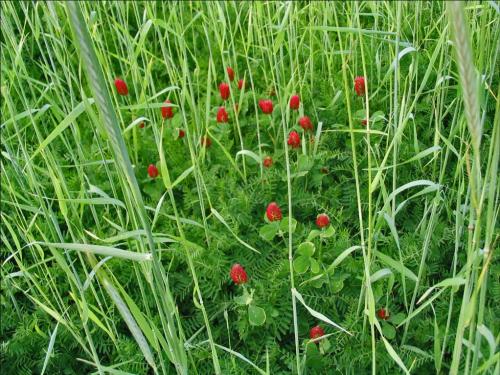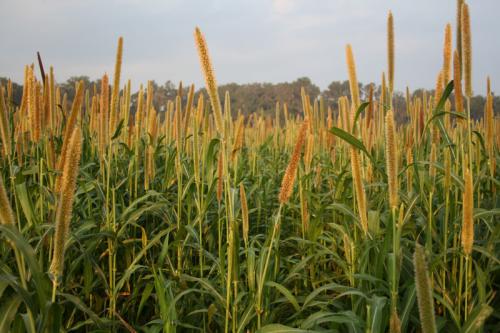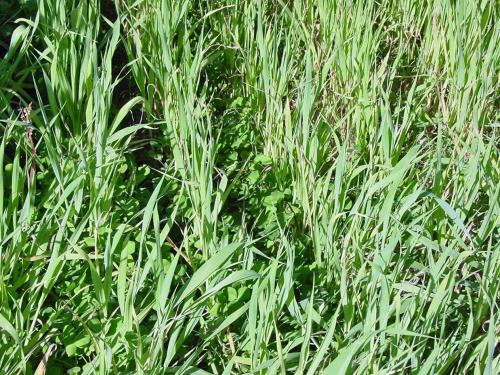eOrganic author:
Danielle Treadwell, University of Florida
Sources:
Excerpts from: Treadwell, D., W. Klassen, and M. Alligood. 2008. Annual cover crops in Florida vegetable systems Part I. Objectives: Why grow cover crops? HS387. Institute of Food and Agricultural Sciences, University of Florida, Gainesville. (Available online at: http://edis.ifas.ufl.edu/HS387) (verified 3 Dec 2008).
Excerpts from: Sarrantonio, M. 1994. Northeast cover crop handbook. Soil health series. Rodale Institute, Emmaus, PA. (out of print)
What are cover crops?
(This section is excerpted from Treadwell et al. [2008].)
Cover crops are crops grown to improve the farming system. Cover crops are typically planted between rotations of income-producing crops, but they can also be planted at the same time. Cover crops fulfill a wide variety of management objectives and serve as integral components of organic farming systems. There are many species of cover crops to choose from.

Figure 1. A polyculture of crimson clover, cereal rye and hairy vetch used as a green manure cover crop for sweet corn. Planting polycultures increases plant and insect diversity, increases the number of ecosystem services, and decreases risk of crop failure. This photograph was taken in at the University of Florida's Plant Science Research and Education Unit in Citra, FL in early March, one week before termination. Photo credit: Corey Cherr, University of Florida.
Why should I use cover crops on my farm or ranch?
(This section is excerpted from Treadwell et al. [2008].)
Integrating cover crops can have significant ecological impacts on the farming system. Cover crops can improve soil physical, chemical, and biological properties; supply nitrogen; reduce leaching of nutrients and pesticides; reduce erosion; mitigate damage from plant pests and/or reduce their population densities; as well attract beneficial insects. Cover crops can also generate additional income when grown for seed or feed, or as an energy crop. While it is difficult to achieve all of the listed benefits with one crop, producers should select cover crops that offer multiple benefits at once. Producers should also consider potential drawbacks before deciding to include a cover crop. In some instances, the cover crop can require additional labor and expense, delay crop planting, or serve as an alternate host for crop insects or diseases.

Figure 2. A monoculture stand of pearl millet 'Tifleaf3' one week before termination. This stand was seeded at a rate of 25 pounds per acre and produced 3,750 pounds per acre of biomass on a dry weight basis. This photograph was taken in at the University of Florida's Plant Science Research and Education Unit in Citra, FL in August, one week before termination. Photo credit: Danielle Treadwell, University of Florida.
A cover crop should:
- satisfy the producer’s primary reason(s) for cover cropping;
- be easy to establish and maintain with available equipment;
- be well-suited to the local climate and the farm environment;
- not compete with income-generating crops grown simultaneously or subsequently; and
- have the ability to withstand stresses likely to occur such as drought, frost, heat, etc.
Prioritizing objectives for cover crops necessitates an understanding of when and under what conditions benefits can occur. Some benefits occur during cover crop growth, while other benefits occur after cover crop termination. Generally, benefits are only fully realized with a robust stand of cover crop. A wide variety of cover crop species and management options are available to fit a farm operation. Producers have many options in species selection and management, and the selection and management of species will be dictated by producer needs and production constraints.
How are cover crops used in farming systems?
(This section is excerpted from Sarantonio [1994].)
Cover crops are integrated into organic farming systems in many ways. They are used in rotation in vegetable and dairy pasture systems, as living mulches, as green manures, and as a mulch on the soil surface. Cover crops provide many benefits, but there is no single cover crop that will fullfill all your requirements in every situation. Read the steps below for an overview on how to select a cover crop for your operation. Then, visit the specific cover crop profiles for recommended cultural practices for examples of how cover crops are used in farming systems.
1. Identify the main objectives
Producers must first prioritize their reasons for planting a cover crop. There are a number of benefits cover crops can provide. These include:
- provide nitrogen;
- add organic matter;
- improve soil structure;
- reduce soil erosion;
- provide weed control;
- manage nutrients;
- provide food for pollinators; and
- furnish moisture-conserving mulch.
You might also want the cover crops to provide habitat for beneficial organisms, better traction during harvest, faster drainage, or another benefit. A few species known to provide these additional benefits should be tested in the farming system, prior to planting a large area.

Figure 3. A biculture of black oats and crimson clover are drilled in alternating rows as a green manure cover crop for sweet corn. This photograph was taken in January at the University of Florida's Plant Science Research and Education Unit in Citra, FL. Photo credit: Corey Cherr, University of Florida.
2. Identify the best place and time
Sometimes it’s obvious where and when to use a cover crop. For example, you might want plant a legume to add some nitrogen before a corn crop, or plant a perennial ground cover in a vineyard or orchard to reduce erosion or improve weed control. If secondary goals such as soil building are an objective, then it may become more difficult to decide where and when to schedule cover crops. To plan how and where to use cover crops, try the following exercise:
Look at your rotation. Make a timeline of 18 to 36 monthly increments across a piece of paper. For each field, pencil in current or probable rotations, showing when you typically seed crops and when you harvest them. If possible, add other key information, such as rainfall, frost-free periods, and times of heavy labor or equipment demand. Look for open periods in each field that correspond to good conditions for cover crop establishment, under-utilized spaces on your farm, as well as opportunities in your seasonal work schedule. Also, consider ways to extend or overlap cropping windows.
3. Describe the niche
Refer to your timeline chart and ask questions such as:
- How will I seed the cover?
- What’s the weather likely to be then?
- What will soil temperature and moisture conditions be like?
- How vigorous will other crops (or pests) be?
- Should the cover be low-growing and spreading, or tall and vigorous?
- What weather extremes and field traffic must it tolerate?
- Will it winterkill in my area?
- Should it winterkill, to meet my goals?
- What kind of regrowth can I expect?
- How do I kill it and plant into it?
- Will I have the time to make this work?
- What’s my contingency plan, and risks, if the crop doesn’t establish or doesn’t die on schedule?
- Do I have the needed equipment and labor?

Figure 4. Chris Reberg-Horton, Assistant Professor in the Crop Science Department from North Carolina State University in Raleigh, NC, explains how roller crimpers are used to terminate cover crops to a group of county extension faculty visiting from the University of Florida. Roller crimpers terminate the crop by crimping the stems, thus interrupting the flow of nutrients and water through the plant. This system allows the plant residue to remain on the soil surface. Photo credit: Danielle Treadwell, University of Florida.
4. Select the best cover crop
You have identified a goal, a time, and a place; now specify the traits a cover crop would need to work well. Several examples of how cover crops are integrated into farming systems are provided in An Introduction to Cover Crop Species for Organic Farming Systems as well as in individual cover crop species profiles linked therein.
5. Settle for the best available cover
It’s likely the “wonder crop” you want doesn’t exist. One or more species could come close. Top regional cover crop species can provide a starting point. Keep in mind that you can mix two or more species, or try several options in small areas. Check with regional experts. Attend cover crop sessions during regional organic farming conferences. Visit with experienced organic producers during field day events.
6. Build a rotation around cover crops
It’s hard to decide in advance every field’s crops, planting dates, fieldwork, or management needs. One alternative is to find out which cover crops provide the best results on your farm, then build a rotation around those covers, especially when trying to tackle some tough soil improvement or weed control issues. With this “reverse” strategy, you plan cover crops according to their optimum field timing, and then determine the best windows for cash crops. A cover crop’s strengths help you decide which cash crops would benefit the most. For now, however, you probably want to fit one or more cover crops into your existing rotations.



